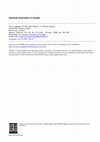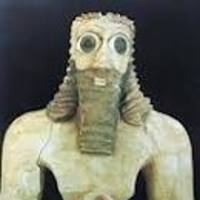Journal Articles and Chapters by Pauline Ripat
History of Education: Ancient Greece and Rome, 2020

Mouseion, 2019
Roman evidence for relations between sisters is thin, but what there is suggests that sororal rel... more Roman evidence for relations between sisters is thin, but what there is suggests that sororal relations were, like all familial relations, subject to ideals of behaviour that might be difficult for individuals to attain. Ideally, sisters, as almost interchangeable versions of each other, were supposed to offer each other unstinting and selfless support, particularly in the context of childrearing. However, these ideals could be difficult to achieve in light of the habit of assessing a woman's worth with reference to her ability to produce children and the reality of high child mortality rates; envious feelings between sisters might take over. Rituals on the dies lustricus and the annual rites of the Matralia may have addressed the incompatibility of the ideals that framed female existence. Il n'y a pas beaucoup de preuves sur les relations entre les soeurs romaines, mais ce qui existe suggère que les relations sororales étaient, comme toutes les relations familiales, soumises à des idéaux de comportement qui pouvaient être difficiles à atteindre pour les individus. Idéalement, les soeurs, en tant que versions presque interchangeables les unes des autres, étaient censées s'offrir mutuellement un soutien désintéressé et sans réserve, en particulier dans le contexte de l'éducation des enfants. Cependant, ces idéaux pouvaient être difficiles à réaliser en raison de l'habitude d'évaluer la valeur d'une femme par rapport à sa fécondité en combinaison avec des taux élevés de mortalité infantile, et la jalousie entre soeurs pouvait entrer en jeu. Les rituels sur le dies lustricus et les rites annuels de Matralia ont peut-être abordé l'incompatibilité des idéaux qui influençaient l'éxperience féminine.

Phoenix, 2016
Among the beloved relatives to whom Ausonius delivers poetic tribute is Aemilia Hilaria, a maiden... more Among the beloved relatives to whom Ausonius delivers poetic tribute is Aemilia Hilaria, a maiden aunt on his mother's side who died at the age of 63. Ausonius praises her for her boy-like nature and appearance, her commitment to virginity, and her skill in practising medicine "like men do" (more virum medicis artibus experiens, Parentalia 6.6). Since medical professionals were not exclusively male, Ausonius must mean that his aunt joined the ranks of female health professionals who adhered to the various schools of medical philosophy usually associated with male physicians. 1 But these schools of thought were not the only frameworks within which illness was interpreted and cures were activated, and implicit in Ausonius' compliment to his aunt is the suggestion that the frameworks and practices she had rejected were associated with females: she did not practise medicine "like women do." What constituted a "female" type of healing, and why was it so objectionable? These questions are at the heart of this discussion, which seeks to find coherence among the various representations of women affecting the health of others. It is difficult to know how to understand in both ancient sources and modern scholarship women who, in contrast to Aemilia Hilaria, practised medicine like women. Unlike the proponents of named schools of medical philosophies, their practices did not have a literary tradition, but instead belonged to a murky, heterogeneous, and poorly documented folk tradition. 2 We do have some descriptive titles, however, which appear to have been considered largely synonymous by sources such as Festus; these range from "singers" or "chanters" (praecantrices), "wise women" (sagae), "purifiers" (piatrices and expiatrices), and "imitators" (simulatrices) to the "number of old women (gr‰ew/aniles)" whose opinions are generally mentioned in ancient literature as emblematic of foolishness. 3 These This article is dedicated, with thanks that extend beyond its pages, to Keith Bradley, whose tutelage and publications have long fostered my own research interests. I have benefited from discussions with Fanny Dolansky and Ian Moyer, and am grateful to the anonymous reviewers for their guidance. The University of Winnipeg provided financial support for this research. The numbering of the poems of the Priapeia follows Bücheler's 1904 edition; the numbering of Martial's Epigrams follows Shackleton Bailey (1993). Translations are my own unless otherwise indicated.
Daughters of Hekate, 2014
Free at Last! The Influence of Freed Slaves in the Roman Empire, 2012
Classical Philology, 2011

Phoenix, 2006
1\.t some point between the late first century b.c. and the early first century A.D., the languag... more 1\.t some point between the late first century b.c. and the early first century A.D., the language of popular oracular inquiry in Egypt changed from mostly Demotic, the native Egyptian language, to entirely Greek.1 This observation is contentious because of its dependence upon papyrological remains, and so may simply be a function of the problem of the survival of evidence, especially since Demotic texts tend to be published at a much slower rate than Greek papyri.2 But in the twenty years since the demoticist Willy Clarysse commented in print on this shift, no evidence has yet come to light to disprove him.3 There is still not one published oracular inquiry that is both composed in Demotic and belongs to the Roman period in date. The shift is beginning to attract the notice of papyrologists and historians;4 it is remarkable because it is unexpected. Demotic remained the language of Egyptian religion into the third century A.D. Furthermore, Egyptian priests, who held a virtual monopoly over Versions of this article were presented as papers to the Classics Department at Dalhousie University and to the CACW? in 2004. I am grateful to members of those audiences for their suggestions, and to Lea Stirling, Matthew Martin, and Christina Vester for their comments on various drafts. The criticisms and suggestions offered by the anonymous referees have done much to improve the final product. Any remaining errors are of course my own. This observation is based on the collected evidence of Ptolemaic and Roman oracular inquiries from Egypt, preserved on papyri. Taken together, Brashear (1995: 3448-56, esp. 3450, n. 362, and 3453-54), Papini (1992), and Zauzich (2000) offer catalogues and bibliography of most published examples of Demotic and Greek oracular inquiries. The following entries should be added: for Demotic, P. Ash. D. 40-44, published by Martin (2004); for Greek, P.Oxy. LXV 4470; P.Firenze Museo Egiziano inv. 10082; and P.Grenfell II 12 verso. These last two are published by Messen Savorelli and Pintaudi (1996), on which also see Litinas 1997: 210-212 and Valbelle and Husson 1998: 1071. None of the Demotic inquiries is dated later than the first century b.c. by its editor, with one possible exception: Brunsch (1982-83), suggests "ptol. oder r?m." as the date for BM 50145, an inquiry whose text is in a very poor state of preservation. No reasons are offered which would suggest a Roman date over a Ptolemaic date, and consequently this example does not, in my view, provide evidence that Demotic was used for oracular inquiries in the Roman period. See P. Tebt. 284 and Bagnall and Cribiore 2006: 382-384 for private letters that mention either planned or executed oracular consultations. See Oates et al, "Checklist," for the papyrological abbreviations used in this article (available on-line at http://scriptorium.lib.duke.edu/papyrus/texts/clist.html). 2 See, for example, Clarysse 1984; Bowman 1991; and Lewis 1993. Note also that many oracular inquiries still await publication: for notifications of unstudied finds,

Greece and Rome, 2006
The role divination played in allocating, maintaining, and justifying the authority of the senato... more The role divination played in allocating, maintaining, and justifying the authority of the senatorial élite in the Republic has been well established. 1 Attention has also been paid to the use made of unofficial forms of divination by ambitious members of the ruling élite in the later Republic, who sought (often successfully) to make themselves pre-eminent before their peers by claiming personal divine attention. 2 What has received less attention in discussions of prophecy and authority is the role the general population of non-élites played in this ideological system which served the interests of the powerful rich, either collectively or individually, at the expense of the less powerful poor. The following seeks to begin to correct this oversight, as discussion of this factor is urgently needed if the observations just identified are to be considered sound. This is simply because authority, the
Books by Pauline Ripat
As the Romans Did, 3rd Edition
Child, Family, and Ancient Society: Studies in Honour of Mark Golden
Sport and Social Identity in Classical Antiquity: Essays in Honour of Mark Golden.
Themes in Roman Society and Culture, 1st edition
Book Reviews by Pauline Ripat
Locating the Grapevine in the Late Republic : Freedmen and Communication
Free At Last! : The Impact of Freed Slaves on the Roman Empire
Greek Divination (S.I.) Johnston Ancient Greek Divination. Pp. xiv + 193, ills, map. Chichester: Wiley-Blackwell, 2008. Paper, £16.99, €23 (Cased, £50, €67.50). ISBN: 978-1-4051-1573-5 (978-1-4051-1572-8 hbk)
The Classical Review, 2009

Journal of Roman Studies, 2015
epideictic is a useful contribution, and such conceptualization helps distinguish it from Republi... more epideictic is a useful contribution, and such conceptualization helps distinguish it from Republican practice. L. makes a welcome contribution by bringing a range of related issues together. As always, a new frame elicits further questions. Why did Augustus turn to the visual at this particular moment and what are the communicative advantages of material discourses? How and why did verbal expression become inadequate to bear the message? Is the visual eld the primary sphere of Augustan political messaging or is it supplemental? L. uses as a springboard some remarks by George A. Kennedy, The Art of Rhetoric in the Roman World (1972), in which he identies Augustan art as rhetorical (2, 155). She sprinkles references to modern rhetorical theory throughout the book. To it she owes concepts such as 'political myth' and 'vernacular discourse', which usefully describe Augustan ideology and its uptake by people lower down the pecking order as a way of integrating themselves into broader structures of power. If its target audience is in fact modern scholars of rhetoric, L. does a superlative job of classical outreach. She brings antiquity in a very accessible package to non-specialist, but interested, readers for whom the technicalities of Classics are surely off-putting. The book is well illustrated and clearly written. Many of the chapters, particularly those on the Augustan political myth, coinage and the altars of the Lares Augusti could well be assigned to undergraduates in a course on Augustan culture, if the comparable treatments in P. Zanker, The Power of Images in the Age of Augustus (2003) and K. Galinsky, Augustan Culture (1988) seem too long.
The Material Lives of Roman Slaves by Sandra R. Joshel and Lauren Hackworth Petersen
Phoenix, 2015
Jeffrey Beneker and Georgia Tsouvala (eds.). The Discourse of Marriage in the Greco-Roman World
Mouseion











Uploads
Journal Articles and Chapters by Pauline Ripat
Books by Pauline Ripat
Book Reviews by Pauline Ripat